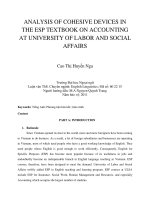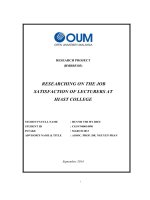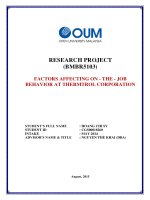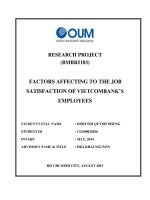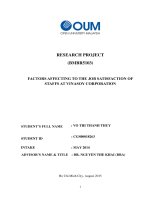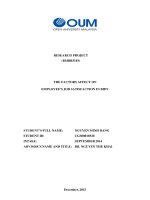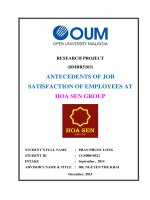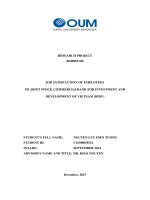The factors affect on employees job satisfaction of BIDV
Bạn đang xem bản rút gọn của tài liệu. Xem và tải ngay bản đầy đủ của tài liệu tại đây (1.36 MB, 87 trang )
RESEARCH PROJECT
(BMBR5103)
THE FACTORS AFFECT ON
EMPLOYEE’S JOB SATISFACTION IN BIDV
STUDENT’S FULL NAME:
NGUYEN MINH DANG
STUDENT ID:
CGS00018528
INTAKE:
SEPTEMBER 2014
ADVISOR’S NAME AND TITLE: DR. NGUYEN THE KHAI
December, 2015
ADVISOR’S ASSESSMENT
----------------------------------------------------------------------------------------------------------------------------------------------------------------------------------------------------------------------------------------------------------------------------------------------------------------------------------------------------------------------------------------------------------------------------------------------------------------------------------------------------------------------------------------------------------------------------------------------------------------------------------------------------------------------------------------------------------------------------------------------------------------------------------------------------------------------------------------------------------------------------------------------------------------------------------------------------------------------------------------------------------------------------------------------------------------------------------------------------------------------------------------------------------------------------------------------------------------------------------------------------------------------------------------------------------------------------------------------------------------------------------------------------------------------------------------------------------------------------------------------------------------------------------------------------------------------------------------------------------------------------------------------------------------Advisor’s signature
NGUYEN THE KHAI
Nguyen Minh Dang – MBAOUMK15C
1
ACKNOWLEDGEMENT
This study is made possible through the help and support from everyone,
including: parents, lecturers, family, friends, colleagues and in essence, all of the
others who help me to complete this study. Especially, please allow me to dedicate my
acknowledgment of gratitude toward the following significant advisors and
contributors:
First and foremost, I would like to thank Dr. Nguyen The Khai for his most
support and encouragement. He kindly read my study and offered invaluable detailed
advices on grammar, organization, and the theme of the study.
Second, I would like to thank my classmates to provide valuable advices and
supports for my pursuit of the master degree.
Finally, I sincerely thank to my parents, family, and colleagues, who provide
the advices and supports. The product of this study would not be possible without all
of them.
Nguyen Minh Dang – MBAOUMK15C
2
TABLE OF CONTENTS
ADVISOR’S ASSESSMENT ......................................................................................... 1
ACKNOWLEDGEMENT ............................................................................................. 2
LIST OF FIGURES ........................................................................................................ 5
LIST OF TABLES .......................................................................................................... 6
ABBREVIATIONS ......................................................................................................... 7
ABSTRACT .................................................................................................................... 8
CHAPTER 1: INTRODUCTION .................................................................................. 9
Company Introduction ................................................................................................... 9
Handbook Of BIDV Brand Identity ............................................................................. 9
History Of BIDV ........................................................................................................... 10
Fields Of Operations ..................................................................................................... 11
Human Resources ......................................................................................................... 12
Network ......................................................................................................................... 12
Customers ...................................................................................................................... 12
Technology..................................................................................................................... 13
Commitment .................................................................................................................. 13
Business Reputation Of BIDV ...................................................................................... 13
BIDV Overview ............................................................................................................. 14
RESEARCH INTRODUCTION ................................................................................. 17
Statement of the Problem ............................................................................................. 17
RESEARCH OBJECTIVES ....................................................................................... 17
RESEARCH QUESTIONS ......................................................................................... 18
Scope Of The Study....................................................................................................... 18
Research Design ............................................................................................................ 18
Value of Research ......................................................................................................... 19
CHAPTER 2: LITERATURE REVIEW .................................................................... 20
JOB SATISFACTION .................................................................................................. 20
ORGANIZATIONAL JUSTICE ................................................................................ 24
WORK - FAMILY CONFLICT ................................................................................. 25
PERSON - ORGANIZATION FIT ............................................................................. 27
Nguyen Minh Dang – MBAOUMK15C
3
WORKPLACE VALUES ............................................................................................ 29
CHAPTER 3: RESEACH MODEL AND HYPOTHESES ....................................... 32
Research Model .............................................................................................................. 32
Dependent Variables: ...................................................................................................... 32
Independent Variables: ................................................................................................... 32
Constructs: ...................................................................................................................... 32
RESEARCH HYPOTHESES ...................................................................................... 33
Instruments ..................................................................................................................... 39
Sampling Method and sample size:................................................................................. 42
Data Analysis Method: ................................................................................................... 43
Method of Data collection............................................................................................... 45
Demographic Characteristics of the Respondents ........................................................... 47
Reliability Analysis ......................................................................................................... 49
DESCRIPTIVE STATISTICS..................................................................................... 51
Correlations among variables.......................................................................................... 51
Hypotheses Testing Results ............................................................................................ 52
CHAPTER 5: CONCLUSION ..................................................................................... 55
Summary and Discussion: ............................................................................................... 55
LIMITATION AND RECOMMENDATION FOR FUTURE RESEARCH .......... 56
THE LIMITATIONS OF THE STUDY: .................................................................... 56
RECCOMENDATIONS .............................................................................................. 56
REFERENCES ............................................................................................................. 58
APPENDIX 1 ................................................................................................................. 71
APPENDIX 2 ................................................................................................................. 80
Nguyen Minh Dang – MBAOUMK15C
4
LIST OF FIGURES
Figure 1: Proposed Research Model of Employee’s Job Satisfaction in BIDV
Figure2: A summary of demographic characteristics of the respondents
Nguyen Minh Dang – MBAOUMK15C
5
LIST OF TABLES
Table 1: Summary of Hypotheses
Table 2: Cronbach's Alpha- Internal consistency
Table 3: Summary of Cronbach’s Alpha of the variables
Table 4: Descriptive Statistics
Table 5: Correlations among Variables
Table 6: Model Summary of all hypotheses
Table 7: Coefficients of all hypotheses
Table 8: Hypotheses Statistic Results
Nguyen Minh Dang – MBAOUMK15C
6
ABBREVIATIONS
Joint stock commercial bank for investment and
BIDV
development of Vietnam
HRM
Human Resource Management
SPSS
Statistical Packages for the Social
JS
Job Satisfaction
OJ
Organizational Justice
DJ
Distributive Justice
PJ
Procedural Justice
WFC
Work – Family conflict
POF
Person – organization fit
VA
Workplace values
Nguyen Minh Dang – MBAOUMK15C
7
ABSTRACT
Job Satisfaction can be defined as the level of positive emotions or attitudes
that individuals have toward their work. When an employee says he has a high job
satisfaction, which means that he really liked his work, felt good about it and the
dignity of his work. Job satisfaction is an important technique used to motivate
employees to work harder.
This study purposely head to recognize the factors that affect the jo b
satisfaction among the employees working at BIDV. The study’s results indicated
three factors (variables) which clearly laid effects on the employee ’s Job
Satisfaction in BIDV named particularly the following terms: Organizational Justice,
P e r s o n - Organizational fit and Workplace Values.
Data analysis revealed that there is a positive relationship between the each
factor of employee’s Job Satisfaction and the following factors: Organizational
Justice, Work – Family conflict, P e r s o n - Organizational fit, Workplace Values.
Furthermore, relevant recommendations for improving the employee satisfaction are
proposed.
Nguyen Minh Dang – MBAOUMK15C
8
CHAPTER 1: INTRODUCTION
Company Introduction
As a long-established bank, BIDV has funded many investment projects and
key economic areas of the country. Joint Stock Commercial Bank for Investment and
Development of Vietnam (BIDV) has also built the largest enterprise customers, while
confirming the implementation of prestigious items, objectives, economic programs
and social security of the country.
- Full name: Ngân hàng TMCP Đầu tư và Phát triển Việt Nam.
- International Transaction Name: Joint Stock Commercial Bank for Investment
and Development of Vietnam.
- Abbreviated name: BIDV
- Address: BIDV Tower, 35 Hang Voi Street, Hoan Kiem District, Hanoi City.
- Tel: 04.2220.5544
- Fax: 04. 2220.0399
- Website: www.bidv.com.vn.
- Email:
Founded on 04/26/1957, BIDV is the oldest Commercial Bank in Vietnam.
Handbook Of BIDV Brand Identity
BIDV is one of the banks which pay early attention to the building up basic
elements for a brand identity system. Logo with its symbol in olivary fruit shape. (but
without “BIDV” phrase) was designed directly by Former Chairman of Director
Nguyen Van Doan in 1990 and was officially publicized on 25th September 1991 by
slogan "Effective Business of customers is the goal of BIDV”.
The launch of "brand identity handbook" was a success in building BIDV
brand in 2009. Brand identity system of BIDV becomes an effective promotional tool
Nguyen Minh Dang – MBAOUMK15C
9
and is the property of BIDV.
In 2003, BIDV edited its logo with two parts: image and text "BIDV". Also in
2003, BIDV registered the logo at the Department of Intellectual Property of Vietnam.
BIDV registered the brand in the U.S. market in 2005.
On 12th March 2006, BIDV decided to use the motto: "BIDV - Sharing
opportunity and successful co-operation", the author of which is Chairman of BOMBIDV Tran Bac Ha. In the short, concise manner, the slogan "Share opportunity and
co-operate successfully” has accompanied with BIDV from then on.
To meet the requirements for using the logo of the enterprise flexibly and
synchronically, the particular colors and details are adjusted to make it look strong and
sharp
After the pilot application of brand identity was executed in some branches and
after the evaluation process, it showed the effectiveness of media, BIDV introduced
the handbook “Handbook of BIDV brand identity.”
Handbook of BIDV Brand identity defines in detail about 5 document groups
with 71 standardized items include:
- Logo and standard system;
- Signage system;
- Office Publications System;
- Media Documents;
- Uniforms.
Stabilizing brand identity elements and the launching of "Handbook of BIDV
brand identity” in 2009 has created an effective promotional tool, increase awareness
of brand, reinforce and confirm the brand image of BIDV. In the long term, the brand
identity will contribute to increase stability and position of BIDV in the marketplace.
History Of BIDV
History of construction and development of BIDV is a difficult and trial but
very proud path associating with historic period against invaders and country
construction of Vietnam people.
Nguyen Minh Dang – MBAOUMK15C
10
- Founded on 26th April 1957 under the name Bank for Construction of
Vietnam.
- From 1981 to 1989: Under the name Bank for Investment and Construction of
Vietnam.
- From 1990 to 27/04/2012: Under the name Bank for Investment and
Development of Vietnam (BIDV).
- From 27/04/2012 to now: Under the name Joint Stock Commercial Bank for
Investment and Development of Vietnam (BIDV).
History of construction and development of BIDV is a difficult and trial but
very proud path associating with historic period against invaders and country
construction of Vietnam people.
Along with country development, Joint Stock Commercial Bank for Investment
and Development of Vietnam contributed to postwar economic rehabilitation and
implementation of the first five-year plan (1957-1965). Vietnam must carry out two
strategic duties for building socialism. They are to be against sabotage of America
toward the North and to reinforce the South for national unity (1965-1975),
construction and development of national economy (1975-1989) and implementation
of the reform in banking activity serving country’s modernization (1990-now). In any
circumstances, BIDV personnel always accomplish their mission- to be a solider of
the Party on monetary financial front and investment and development of country…
Acknowledge the contribution of BIDV through the periods, the Party and the
Socialist Republic of Vietnam have given to BIDV a lot of noble titles and rewards
including First-Rate Independence Medal and Third-Rate Independence Medal; FirstRate, Third- Rate Labor Medal, recognize as hero of Labor in renovation period, Ho
Chi Minh Medal, etc.
Fields Of Operations
Bank: BIDV functions as a leading experienced bank of finance services,
brokerage, loan syndication and advisory, modern, convenient banking products.
Insurance: BIDV provides products for non-life insurance designed to match
the overall package to customers of BIDV.
Nguyen Minh Dang – MBAOUMK15C
11
Stock: BIDV provides a wide range of brokerage services, investment and
investment consultant with the ability of quickly developing a system of agents to
receive orders nationwide.
Financial investments: BIDV includes financial leasing, security trading and
capital contribution with the aim at establishing investment companies to the project;
Especially, it plays a leading role in coordinating key projects of the country such as
company Aviation stock leasing (VALC) development company highway (BEDC),
Investment, Long Thanh International Airport …
Human Resources
With more than 18,000 officers, employees and financial consultants who are
well-qualified and well-trained with full experience and have been accumulated and
transferred for over half of a century, BIDV always brings its customers the benefits
and reliability.
Network
- Banking Network: BIDV has 127 branches and 600 transaction offices,
thousands of ATM and POS transactions in 63 provinces and cities nationwide
- Non-banking Networks: consists of Investment Securities Company (BSC),
Insurance and Investment Company (BIC) and Leasing Company with more than 20
branches nationwide.
- Overseas representatives: It trades on all three sectors: Banking, Insurance
and Financial Investment in Laos, Russia and especially in the Cambodian market
(Investment and Development Company of Cambodia – IDCC, Investment Banking
and Development of Cambodia – Cambodian BIDC, Insurance Company – CVI.
- Joint venture Bank: Co-operates more effectively with international partners
such as Bank VID-Public Venture (partner Malaysia), Bank of the Lao-Vietnamese
joint venture (with partner Laos), Vietnam Russia Joint Venture Bank – VRB (with
partners Russian), BIDV Tower Joint Venture Company (Singapore partner), and
venture investment management BIDV – Vietnam Partners (U.S. partner), etc.
Customers
Nguyen Minh Dang – MBAOUMK15C
12
BIDV trades with:
- Enterprises: corporations, big corporations, small and medium enterprises
- Financial institutions: BIDV is the reliable choice for a number of Financial
institutions such as unilateral and multilateral World Bank, ADB, JBIC, NIB …
- Individuals: Millions of individuals have used the services of BIDV. It has
continuously tried to reach the goal of becoming a retail bank of high standards.
Technology
- BIDV always has innovations and technology applications serving effectively
for the management and development of advanced banking services, developing the
most advanced information technology systems such as ATM, POS, Contact Center,
to consolidate and develop all infrastructure systems such as monitoring of network
resources, network-oriented services (SONA), access control workstation; enhance
information processing service, banking executive management MIS; CRM.
- Since 2007, BIDV has occupied the leading position in the top list of
Vietnam ICT Index (index available for application development and information
technology) and in the typical Top 10 CIO (Information Technology Leadership) in
the area of Indochina in 2009 and of ASIA in 2010.
Commitment
- Customers: BIDV always provides all customers with high quality
products and modern banking service and it is the last to be responsible for the given
services.
- To other partners: BIDV is willing to “share the opportunity and co-operate
successfully”.
- To Working staff: BIDV follows the motto “each staff must be a competitive
edge” in both professional skills and personal virtue. For this reason, BIDV has
continually paid attention to ensuring legitimate rights, improving physical and
spiritual life of its employees to make them feel comfortable and inspired to serve in
BIDV.
Business Reputation Of BIDV
Nguyen Minh Dang – MBAOUMK15C
13
- BIDV is the choice, the trust for economic organizations, the leading
enterprise of both countries and individuals in accessing the financial and banking
services.
- BIDV has been known and recognized as one of the largest banking brand in
Vietnam and certified as a trademark in the U.S. and also rewarded annually from
organizations, financial institutions at home country and abroad.
- BIDV is always the pride of generations of staff and financial and banking
sector in 55 years with traditional professional development investment for the
country.
BIDV Overview
- In 2014, Vietnam's economy faced many challenges. However as a result of
close and aggressive directions by the Government and State Bank, as well as the
consensus and efforts of the business community, banking sector and the people,
Vietnam’s economy made positive changes, opening positive economic outlook for
2015. Given the above positive developments, BIDV as one of the leading financial
institutions outperformed business targets set for 2014 by the General Shareholders’
Meeting. The Bank had improved credit rating and achieved positive results in
implementing the restructuring scheme of the period 2013-2015.
- As of 31 December 2014, BIDV’s total assets stood at VND650 trillion
(~USD31 billion), up 18.6% year-on-year. Outstanding loans reached VND460
trillion (~USD21 billion), up 18.9% year-on-year. NPL ratio was well controlled at
2.03%. Total fund mobilization hit over VND501 trillion (~VND24 billion), up
20.4%. Profit before tax amounted to VND6,297 billion (up 20%). BIDV’s financial
ratios were all within safe limits, with CAR at over 9%, ROA at 0.83% and ROE at
15.27%.
- Notably, in 2014, for the first time in three years the retail credit growth
reached nearly 36%, retail deposit growth at 25%, individual customer base at nearly
7 million. This success proved the Bank’s growing capability and market position in
its business operations.
- In 2014, Moody's upgraded BIDV’s rating by one notch, up to B1. Moody’s
Nguyen Minh Dang – MBAOUMK15C
14
assessed that BIDV had an extensive network and the best payment system in
Vietnam. Standard & Poor’s held steady their ratings of BIDV, showing the BIDV’s
stable operation as well as increasing international trust in the Bank.
- In addition to the credit rating upgrading, BIDV also won prestigious
domestic and international awards such as “Best Commercial Bank in Vietnam 2014”
(awarded by International Banker), “Best Retail Bank in Vietnam” (by Asian Banker),
“Outstanding e-Bank 2014” by the Vietnam Banks Association in collaboration with
International Data Group (IDG); “Vietnam Value” by Vietnam Ministry of Industry
and Trade.
- As a leading financial institution, BIDV proactively and effectively executed
the policies of the Government and State Bank of Vietnam, proactively administering
credit growth focused on priority areas. The Bank also took measures to support the
enterprises to overcome difficulties, successfully implemented the key credit
programs.
- BIDV continued to affirm its position and strategic vision in researching,
forecasting,
consulting
and
making
recommendations
on
macroeconomic
management, finalization of market economy institutional framework, continued to be
a channel providing information independently, objectively and reliably, effectively
serving the Bank’s governance as well as supporting policy-making and
macroeconomic management for the innovation and development of the country.
- In international cooperation, BIDV continued to strengthen the Bank’s role as
chairman of the Association of Vietnamese Investors in Laos, Cambodia and
Myanmar; enhanced trade and investment promotion in potential markets such as
Russian Federation, Europe, Northeast Asia. BIDV also made important steps in
entering and connecting Japan – Vietnam markets; partnered with US-based MetLife
Inc. to establish a joint venture named BIDV MetLife in Vietnam.
- In 2014, BIDV focused on institutional development under the model of a
modern commercial bank, improving risk management capacity under Basel II
standards, promoting the implementation of the restructuring scheme, and enhancing
corporate governance to meet the international standards and practices.
- Corporate Social Responsibility (CSR) programs continued to be a focus of
BIDV through various activities to support the national target programs on healthcare,
Nguyen Minh Dang – MBAOUMK15C
15
education, national disaster rescue, and East Sea protection. As the focal point, BIDV
made significant contribution to the success of the Rural Finance Project III – the
project assessed to have “an outstanding performance among Vietnam’s ODA
projects”, significantly contributing to the economy, society and environment.
- BIDV completed the year 2014 with positive results, satisfying the
governance requirements for a large and modern commercial bank. The Bank operated
securely and stably, ensuring employees’ income and shareholders’ benefits. BIDV is
also friendly and responsible to the community, enhancing and developing its brand
locally and abroad.
- In 2015, with stable and positive outlook for the economy, especially when
Vietnam makes deep international integration, notably the participation in ASEAN
Economic Community (AEC) and the Trans-Pacific Partnership (TPP), BIDV
continues to make strong innovation, preparing resources to support enterprises and
customers across all sectors, promoting production and trade, as well as improving
competitiveness for sustainable development and integration.
- For BIDV, 2015 is also the final year of the period 2011-2015 and the ending
year of the restructuring scheme for the period 2013-2015. BIDV‘s strategic direction
set out for 2015 and the period 2016-2020 is to continue INNOVATION,
INTEGRATION and DEVELOPMENT with the mission of supporting and providing
the best and modern banking – financial services to customers, bringing the best
values to shareholders and benefits to employees.
- BIDV believes that with the Bank’s strong position earned during the 58-year
history, professional human resources, cutting-edge and synchronous technology,
determination to make innovation and breakthroughs, as well as the trust of customers,
investors and employees, BIDV will successfully fulfill the goals set for 2015 in
particular and the period 2011-2015 in general, laying a firm foundation for the period
2016-2020 and the strategic direction to 2030.
Nguyen Minh Dang – MBAOUMK15C
16
RESEARCH INTRODUCTION
Statement of the Problem
Human life has become very complex and easily to be incomplete nowadays. In
modern society, the needs and requirements of people are growing and changing ever
and ever. When people are growing and changing needs of them and of course cannot
fulfill theirs, they become dissatisfied. The dissatisfaction is likely to contribute very
little for any purpose. Job satisfaction is one of the most popular theme and is widely
studied in the field of organizational psychology (Spector, 1997). Locke (1976) defines
job satisfaction as a happy state or positive emotions by evaluating the experience of a
job or task. Job satisfaction was studied both as a consequence of many individual
characteristics and environmental work and is a prerequisite for many results. Workers
with higher job satisfaction are less absent, less likely to leave, higher productivity,
more visibility of organizational commitment, and more likely to be satisfied with their
lives (Lease, 1998). Job satisfaction of employees is a very important branch to operate
the businesses successfully.
Furthermore, enhance the Job Satisfaction level of the employees will maintain
the stability of the workforce, reduce operating costs and increase business
productivity. Raising the level of employee satisfaction not merely increase. There are
many simple methods, inexpensive ways to help managers improve satisfaction and
increase the level of commitment as well as the job satisfaction of staff.
Last but not least, this is the transparent period when Housing Bank of Mekong
delta (MHB) was merged into BIDV. So the most important action for the managers
of BIDV is to maintain the current system and training the staff from MHB to keep up
with the current staff of BIDV. One of the most essential factor is to master the job
satisfaction of the employees right in this period.
As a result in this study, I focused only on identifying and analyzing the
impacts of these factors on job satisfaction of employees of BIDV based on survey
data of 400 employees in the bank.
RESEARCH OBJECTIVES
This study will need to find out which factors affect the employees' satisfaction
Nguyen Minh Dang – MBAOUMK15C
17
and how to improve it. To achieve this terminal goal, we need to achieve these
specific objectives:
- Organizational Justice (OJ).
- Work – Family conflict (WFC)
- Person – Organization fit (POF)
- Workplace values (VA)
RESEARCH QUESTIONS
Depending on the statement above, and to fulfill the objectives of this study,
these research questions have been formulated:
1. The relationship between Organizational Justice and Job Satisfaction
2. The relationship between Work – Family conflict and Job satisfaction
3. The relationship between Person – Organization fit andJob Satisfaction.
4. The relationship between Workplace Values and Job Satisfaction
Scope Of The Study
Due to the limitation of time and resources, this study only concentrates on
employees who can be contacted to answer the questionnaire. These questions
mainly focus on the satisfaction of employees BIDV with 400 employees.
Research Design
Data collection: Data Collection is the most important step of any type of the
study. A wrong data collection can deflect the results of a study and ultimately go to
invalid results. Data collection methods for impact evaluation vary along a
continuum. At the one end of this continuum are quantitative methods and at the other
end of the continuum are Qualitative methods for data collection. Both primary and
secondary data had been used in present study.
Primary data:
- Surveys received purposely from the employees of BIDV (online surveys,
directly surveys on written copies, email surveys).
- Results of interviews, discussions with employees to g e t better
Nguyen Minh Dang – MBAOUMK15C
18
understanding about the views and plan, as well as reviews of study issues.
Secondary data:
- Selected articles from papers, magazines and internet information.
- Annual and periodical reports that published by BIDV.
Value of Research
This is the role of any managers to take into account the general well being of
their staff. This is crucial in order to create an environment that is both conducive
and harmonious for every role player of an organization. In order to accomplish this
role, managers must have indications of what exactly contributes to the areas of job
satisfaction. The value of this study is to investigate and embrace the levels of job
satisfaction at BIDV. Therefore the researcher will make some recommendations
and suggestions on how to improve on Job Satisfaction at the BIDV.
Nguyen Minh Dang – MBAOUMK15C
19
CHAPTER 2: LITERATURE REVIEW
JOB SATISFACTION
Employee’s Job Satisfaction is the most crucial success factor for all
organizations. Employee’s Jobsatisfactions have been recognized to have a huge
effect on many economic and social phenomena, e.g. economic growth and
higher standards of living. Enterprises must continuously maintain employee
satisfaction in order to stay profitable. Marcson (1960) stated a debate and findings
suggesting that one of the best methods to improve productivity in any
organizations is to provide employees with jobs that are more demanding and
challenging. Herzberg's (1968) theory effectively delineates the reasons of job
satisfaction. According to his two-factor theory, there are motivational and
hygiene factors present in one's job. Rewards and benefits are hygiene factors, so if
they are not present, they will bring dissatisfaction, but their presence will not
necessarily bring job satisfaction. Pritchard, Dunnette, and Jorgenson (1972)
indicate that feelings of underpayment lead to decreased performance and low
productivity. (Hackman & Oldham
(1975)
Hackman
and
Oldham's
Job
Characteristic Model (JCM) has been used to determine the level of job
satisfaction. The model focuses on five cores job dimensions, skill variety, task
identity, task significance, autonomy, and feedback, which in turn influence three
key psychological states: experienced meaningfulness of the work, experienced
responsibility for the work, and knowledge of results. These psychological states
then influence job satisfaction. Locke (1976) defines job satisfaction as a
pleasurable or positive emotional state resulting from the appraisal of one's job or
job experiences. Job satisfaction has been studied both as a consequence of many
individual and work environment characteristics and as an antecedent to many
outcomes. Heneman, Greenberger & Strasser (1988) pay instrumentality, that is, a
linkage between pay and performance has been found to play an important role in
bringing job satisfaction; it influences one's psychological state of being involved
in meaningful work for which one is aptly rewarded. Bolton (1991) at corporate
level, employee satisfaction is affected by many factors such as lighting, furniture,
noise, temperature and other arrangement. It is also dependent on the physical
Nguyen Minh Dang – MBAOUMK15C
20
environment and its affect on health and employees satisfaction. Witt & Nye
(1992), individuals who perceive their promotion decisions are made in a fair and
just manner are likely to experience satisfaction with their jobs. The satisfaction of
employee is analyzed actually by the output that the individual produces and it is
related to office environment. Brown & McIntosh (1998) have found evidence
that the correlation between wage and job satisfaction is particularly close in the
case of low levels of monetary compensation, both within the sector and among
sectors. Lease (1998) employees who have higher job satisfaction are usually less
absent, less likely to leave, more
productive,
more
likely
to
display
organizational commitment, and more likely to be satisfied with their lives. Wagner
and Hollenbeck (1998) job satisfaction, on the other hand, can be defined as a
pleasurable feeling that results from the perception that one’s job fulfils or allows
for the fulfillment of one’s important job values. Blanchflower & Oswald (1999)
job insecurity, work intensity, greater stress, and dissatisfaction with working
hours have increased in the US and in Germany, and they significantly explain the
decline of job satisfaction. Clark (1999) shows that changes in workers’ pay over
time positively influence their well- being, whereas the current level of pay does
not impact on job satisfaction. Leontaridi & Sloane (2001) show that low- pay
workers report higher job satisfaction than do other workers. Borzaga & Depedri
(2005) observe that, even in a sector characterized by low average salaries like the
social- services sector, employees are more satisfied when their wages increase up
to a threshold, but not above that threshold. Clark (2005) the opposite dynamic of
job satisfaction with respect to the economic conditions as represented by wages,
and to job conditions as represented by working time, is also evident. DiazSerrano & Cabral Vieira (2005) show that low-pay worker are likely to have
low-quality jobs and consequently less job satisfaction. Siebern-Thomas’s (2005)
cross-sectional analysis on the European Community Household Panel shows that
the correlation between wage and job satisfaction is significant and positive.
According to Baron et al. (2006), studies have generally indicated a low to
moderate inverse relationship between job satisfaction and employee absence and
turnover. This implies that the lower an individual’s satisfaction with his/her job, the
more likely is that person to be absent from work or to resign and seek other job
Nguyen Minh Dang – MBAOUMK15C
21
opportunities. Sahnawaz and Juyal (2006) focus on investigating the impact of job
involvement and job satisfaction on organizational commitment. Organizational
commitment is considered to be one of the most important and crucial outcomes of
human resource strategies. Furthermore employee commitment is seen as the key
factor in achieving competitive performance. DeVaro, Li, & Brookshire (2007)
focus on the contextual factors that are provided by the organization to ascertain
job satisfaction. The focus on the JCM is primarily driven by two considerations.
First, the JCM still remains the theoretical focal point in the current discussion of
job satisfaction and work design and is still used as a powerful conceptual tool for
job enrichment. Samad (2007) also tried to determine the level of influence job
satisfaction facets will have on organizational commitment. Singh & Kohli
(2006), Thakur (2007) and Jha et al. (2008) shows that organizational contextual
factors such as pay, growth opportunities, job security, among others, influence an
employee's perception of job satisfaction. Green & Heywood (2008) performancerelated pay allows opportunities for worker optimization and does not crowd out
intrinsic motivation, thus increasing overall satisfaction, satisfaction with pay, and
satisfaction with job security. Sharma and Kumari (2004) found that public sector
employees are in a position in terms of their job satisfaction than the employees of
private sector organisations. Top management employees are more satisfied than
the middle and lower level employees. It was also revealed that the public sector
employees are more dissatisfied with their working conditions and incentives than
the employees of the private sector. In a study on employee attitude and job
satisfaction, Saari and Judge (2004) found that job dissatisfaction appears to be
related to
other
withdrawal
behaviours
including
lateness,
unionization,
grievances, drug abuse and decision to retire. Wayne, Musisca and Fleeson (2004)
found that work to family conflict was negatively related to job satisfaction,
while work family facilitation was positively related to job satisfaction. Srivastava
(2005) found from his study involving senior and middle managers in two public
sector companies that the changes in work and service conditions are largely
positive, resulting in greater job satisfaction than before.
Judge, Heller and Klingir (2008) indicated that the traits from all three
taxonomies generally were significantly related to job satisfaction, even when the
Nguyen Minh Dang – MBAOUMK15C
22
traits and job satisfaction were measured with independent sources. However
when all three typologies were examined concurrently the core self evaluation
typology was the only typology that was significantly related to job satisfaction.
Edwards, Bell and Arthur (2008) indicate that the relationship between overall job
satisfaction and task and contextual performance were the same. There was a
stronger relationship between satisfaction with supervision and
contextual
performance compared to task performance. This also states the importance
considering
different
facts
with
job
satisfaction
and
of
job performance
relationship, as well as the importance of matching predictors and criteria in
terms of their levels of specificity. Clark and Tamara (2008) have revealed that
there
was strong correlation between opportunities for promotions and job
satisfaction. The results indicate that external needs, opportunities for promotions,
and pay contribute to job satisfaction and reduction of turnover among employees
within insurance organizations. The problem with job satisfaction and turnover is
a concern within insurance industry. Jain (2010) analysed the impact of
liberalization on HRM practices in public sector banks over a period of almost
two decades. Variables were measured and conclusions were drawn striking a
blend between micro level changes and their consequent impact on banking
operations. Majority of the respondents agreed that the primary reasons for
improved productivity post liberalization were use of IT, Infrastructure,
competition in the market place and outsourcing back office functions. Chopra
and Khan (2010) states that job satisfaction is a complex and multifaceted
concept, which can mean different things to different people. The Link between
job satisfaction and performance may prove to be a spurious relationship, instead,
both satisfaction and performance
are
the result of personality. Hence the
behavioural aspect of HRM has to be kept in mind by the organizational decision
makers
In this study, I use the Job Satisfaction Index to measure the job satisfaction
of the employees of BIDV. This measure was developed by Schriesheim and Tsui
(1980). It uses six items to form an index that describes overall job satisfaction. The
scale includes songle questions to assess the degree of satisfaction with the work
itself, supervision, co-workers, pay, promotion opportunities, and the job in general.
Nguyen Minh Dang – MBAOUMK15C
23
Overall job satisfaction correlated positively with age, tenure, psychological
commitment to the organization, personal coping ability, organizational support for
non-work activities, and intention to stay. It correlated negatively with frequency of
absences, job level, conflict between work and non-work roles, and years in
occupation (Cohen, 1997; Tsui et al., 1992).
ORGANIZATIONAL JUSTICE
Organizational Justice is based on the perception of the staff of the organization
treats workers fairly and only (Folger & Cropanzano, 1998; Greenberg, 1987). While
Organizational Justice is a multidimensional concept, distributive justice and
procedural justice are the two salient dimensions of organizational justice (Folger &
Cropanzano, 1998; Greenberg, 1987, 1990b). Distributive justice deals with the
perceptions that organizational outcomes affecting employees are equitable and fairly
based (Folger & Cropanzano, 1998; Greenberg, 1982). In a sense, perceptions of
distributive justice are based on the exchange principle: employees evaluate the
organizational outputs they receive compared with their inputs to determine whether it
is a fair outcome (Lambert, 2003). A wide array of outcomes shape employee
perceptions, including pay, performance evaluations, assignments, rewards, and
punishments (Greenberg, 1990a, 1990b). Procedural justice refers to employee
perceptions that the process by which distributive outcomes are determined is fair
(Folger & Cropanzano, 1998; Greenberg, 1990a). Employees generally desire the
process to be open and fair, regardless of the outcome. Distributive justice deals with
perceptions of the ends and procedural justice deals with perceptions of the means
In this study, I use the Distributive and Procedural Justice method (not fully
approved because of the limitation of time) developed by Sweeney and McFarlin
(1994). The procedural justice subscale uses 8 items to assess the fairness of
procedures within an organization, including procedures relevant to assessing and
comunicating performance feedback, solving work – related problems, and promotion
processes. Eight items describe employee perceptions of an organization’s fairness in
distributing rewards such as raises, promotions, performance ratings, and general
recognition.
Nguyen Minh Dang – MBAOUMK15C
24

